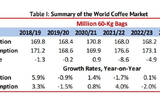Introduction to coffee cultivation, coffee development history, coffee varieties and coffee beans in Antigua producing area in Guatemala
Located in southern North America, Guatemala has tropical rain forests, volcanic soil and a changeable microclimate. These unique conditions give Guatemalan coffee a good growing environment.
According to a common saying, in the mid-18th century, Jesuits brought coffee trees to Antigua to decorate their monasteries. By the early 19th century, there was a record of Guatemalans drinking coffee. At that time, Guatemala's main cash crop was indigo, a plant dye, but was damaged by locusts and the emergence of man-made dyes weakened indigo exports. In order to revive the economy, the Government of Guatemala began to encourage the cultivation of other crops, including coffee. Coffee became an important crop in Guatemala after 1856. Later, in 1960, the National Coffee Association (ANCAFE) was established to strengthen the national economy in terms of coffee production and exports.
At present, Guatemala also grows a number of coffee varieties, including Bourbon, Typica, Kaddura, Catuai, Gesha and so on. In addition to common varieties, some varieties will now be planted.
Pache) Patch Pache is a natural variety of Typica, which is related to a single gene, which causes the plant to become smaller, but it also makes it more intensive to plant and achieve higher yield, but the disease resistance is relatively poor. The variety was discovered in 1949 at the Brito farm in Santa Cruz Naranjo, Guatemala. This variety is most suitable for planting areas with more than 1200 meters and annual rainfall of less than 2500 millimeters, and is currently planted on a large scale in Guatemala.
Tekisic is a bourbon selection produced by the Salvadoran Coffee Institute (ISIC) since 1949 and released in 1977. The selection process of Tekisic is called "large-scale selection" and selects a group of individuals according to their superior performance. A group of individuals selected in the repeated process have a very good quality potential and have a higher yield than the unselected bourbon species. So it is called Tekisic, which means "work" in Navatre. However, this variety is not resistant to major diseases such as leaf rust. Later, planting was introduced in Guatemala and became one of the main varieties in Guatemala.

Mibirizi, probably the oldest variety in Rwanda, was introduced from Guatemala by the German colonial government of Rwanda in 1910. It is likely to be related to the variety of iron pickup, as 100% of the variety of iron pickup was grown in Guatemala at that time. The variety has good quality and drought tolerance, but it is susceptible to major diseases, and now genetic tests have confirmed that it is related to the iron pickup genome.

At present, Qianjie also has coffee beans from Guatemala, Flower God coffee beans from La Minita Manor in Antigua, beans are bourbon and Kaddura, which are washed with water. Boiled with V60 and 1Rod 15, the palate will have citrus and light chocolate flavors, berry-like acidity, rich layers and smooth taste.
Important Notice :
前街咖啡 FrontStreet Coffee has moved to new addredd:
FrontStreet Coffee Address: 315,Donghua East Road,GuangZhou
Tel:020 38364473
- Prev

Ice pupil B75, a filter cup that can "squeeze" sweetness
Last month, Qianjie introduced a more popular cone ice pupil filter cup. The groove design allows the filter paper to fit perfectly and gives the coffee a full and mellow taste. Today, let's get to know its distant relative-Ice pupil B75 filter cup. The ice pupil B75 filter cup is made by Li Jinlong.
- Next

The international coffee organization ICO released its December report: production will increase in the future.
According to a report released by the International Coffee Organization (ICO), global coffee grew by 0.1% to 168.2 million bags in the 2022 coffee year. The reasons for stagnant growth cover changes at the regional level. The coffee world is divided into expanding America and shrinking other parts of the world
Related
- What is the difference between a cake filter cup and a V60 conical filter cup? What are the advantages and disadvantages of the flat-bottomed filter cup brewing solution?
- What is the difference between fine coffee powder and medium coarse coffee powder? Do I need to sift out the fine coffee powder for making coffee by hand?
- Why does hot American coffee taste bitter? Difference in proportional concentration between hot American and ice American
- Is espresso stored overnight in the refrigerator harmful to your body? Is frozen coffee better than freshly ground coffee?
- What parameters and proportions of water temperature should be used to grind and brew fresh coffee beans? Why can't I drink freshly roasted coffee right away?
- Customers have "changed" Manner's new products! Shop assistant: Please don't mess around!
- Remove sockets in customer areas at Starbucks stores?! Netizen: I won't go if I really tear it down
- What is the difference between the taste steps of sun-dried coffee and washed coffee? Why is sun-cured coffee sweeter and washed coffee sour?
- The recipe for salty grapefruit dirty is revealed! Coffee Festival salty grapefruit dirty coffee making materials parameters ratio milk share!
- How about the flavor of Sunlight 74158 at Sidamo Banshaha Mathieu Processing Factory in Ethiopia? 74158 Share the proportion of coffee brewing parameters!

